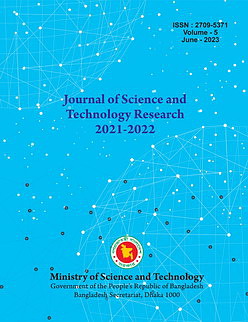Analysis of Phytochemical Constituents, Pharmacological and Ethnobotanical Studies of Selected Folk Medicinal Plant, Curcuma amada Roxb. (Mango Zinger)
DOI:
https://doi.org/10.3329/jscitr.v5i1.74002Keywords:
Curcuma amada, antimicrobial activity, cytotoxicity assay, disc diffusion method, in silico studyAbstract
Curcuma amada, also known as Mango ginger, is a distinctive spice that shares morphological similarities with ginger but imparts a raw mango flavor. The primary use of Curcuma amada rhizome lies in pickle and culinary preparations. In traditional medicinal systems such as Ayurveda and Unani, Curcuma amada is highly valued for its diverse properties, serving as an appetizer, alexteric, antipyretic, aphrodisiac, diuretic, emollient, expectorant, and laxative. It is prescribed to address various conditions, including biliousness, itching, skin diseases, bronchitis, asthma, hiccough, and inflammation from injuries. Despite its extensive traditional use, there is a scarcity of studies exploring the antioxidant, antimicrobial, and cytotoxic activities of Curcuma amada rhizome extract. Antibacterial activity was assessed using the agar well diffusion method against Gram-positive Staphylococcus aureus and three Gram-negative strains- Klebsiella pneumonia, Escherichia coli, and Acetobacter aceti. The study aims to investigate the antimicrobial and cytotoxicity activities, as well as conduct in silico pharmacological analysis of Curcuma amada. In antibacterial tests, a notable zone of inhibition was observed against Acetobacter aceti and Escherichia coli, while none was observed against Klebsiella pneumoniae and Staphylococcus aureus. Cytotoxicity was assessed through a brine shrimp lethality bioassay, revealing results based on mortality numbers and the percentage of affected brine shrimp. In the in silico analysis, which evaluates pharmacological activity through pharmacokinetic analysis and molecular docking, four phytochemicals (E)-.beta.-Farnesene, eupatin, 3-Carene, and coumarin from the plant were selected. These phytochemicals were docked against the Estrogen receptor alpha (ERα), a protein associated with breast cancer. The docking results demonstrated promising binding scores, with E-.beta.-Farnesene, eupatin, 3-Carene, and coumarin scoring -11.3, -6, -6.3, and -8.1, respectively.
J. of Sci. and Tech. Res. 5(1): 143-156, 2023
261
313
Downloads
Published
How to Cite
Issue
Section
License
Copyright (c) 2023 Mst Shuktara Khatun, Md Khasrul Alam, Md Al Amin, Md Rezuanul Islam

This work is licensed under a Creative Commons Attribution 4.0 International License.




